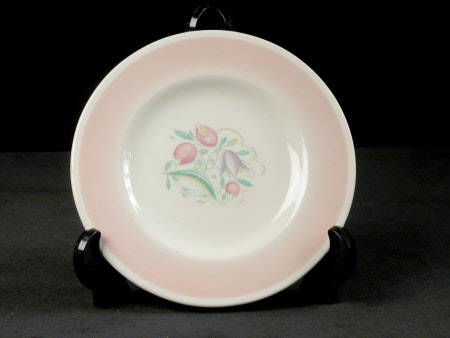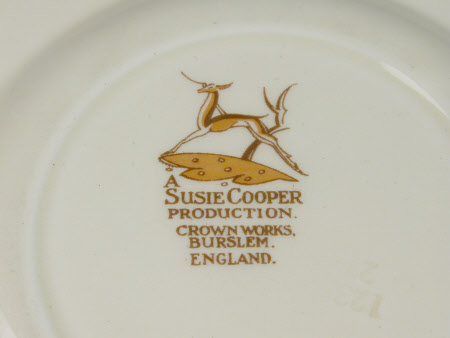Plate
Susie Cooper (1902 - 1995)
Category
Ceramics
Date
1935 - 1960
Materials
Ceramic
Measurements
175 mm (Diameter)
Order this imageCollection
Wightwick Manor, West Midlands
NT 1288770
Caption
Susie Cooper was an extraordinary leader in an industry dominated by men. During a career spanning seven decades, she created ceramics that were renowned for their elegance, affordability and utility. Cooper was born in Staffordshire and attended evening classes at the Burslem School of Art as a teenager. Her teacher was pottery-industry stalwart Gordon Forsyth (1879–1952), who arranged a placement for her at the progressive decorating firm A.E. Gray & Co., where he worked as a freelancer. Cooper was appointed as a designer and decorated the ‘Gloria Lustre’ range, much of which was designed by Forsyth. The company received a Gold Medal for the ware at the 1925 Exposition Internationale des Arts Décoratifs et Industriels Modernes in Paris – the event that launched Art Deco into the world. Aged 27, Cooper established her own business at the Crown Works in 1929. This gave her full creative control over the design process, enabling her to consider both surface decoration and shape. It was a risky decision at a time of economic instability, but one that was ultimately very successful. In 1932 the Pottery Gazette and Trade Review remarked that ‘Miss Susie Cooper … is a gifted, creative artist of the modern school of thought, one who reveals in her work a lovely imagination combined with a unique capacity to achieve the maximum degree of effectiveness in pottery decoration by recourse to the simplest modes of expression.’ Cooper’s ceramics were stylish but affordable. She understood changing consumer tastes and developed a progressive but restrained approach to design that coordinated perfectly with the modern interiors of the suburban middle classes, her typical customers. She made use of innovative techniques for the decoration of her pieces, including ceramic crayons, aerographing (spraying colour onto a pot) and lithographic printing, as well as traditional techniques such as hand-painting and sgraffito (incising a design into the clay surface). As a measure of her success, Cooper was awarded the title of Royal Designer for Industry in 1940. She was the only woman from the Potteries to have achieved this distinction. Cooper’s business was absorbed into the Wedgwood Group in 1966. She continued to produce cutting-edge designs, with influences ranging from Op Art to ancient Egypt. Her ‘Corn Poppy’ design was one of Wedgwood’s best sellers during the 1980s. Her remarkable career was celebrated in a retrospective exhibition at the Victoria and Albert Museum, London, in 1987.
Summary
Side plate, bone china, Susie Cooper, Crown Works, Burslem, Stoke-on-Trent, designed 1935; decorated in the 'Dresden Spray' pattern with a lithographic print of a posy of stylised flowers and foliage at the centre of the well, the border with aerographic decoration in pink.
Makers and roles
Susie Cooper (1902 - 1995)
References
Conroy, Rachel, Women Artists and Designers at the National Trust, 2025, pp. 214-217

